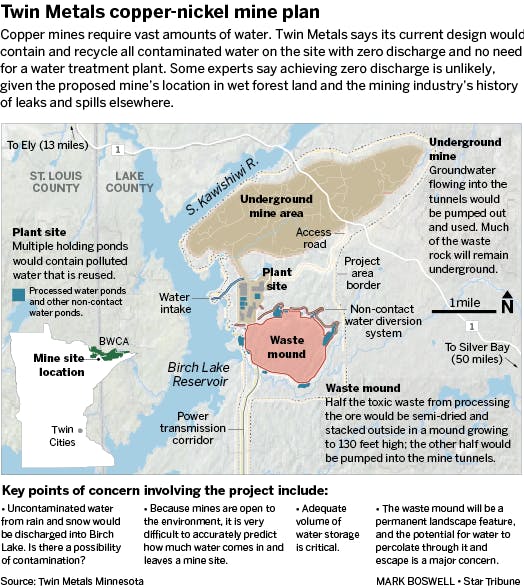The Twin Metals copper-nickel mine would cover nearly 2 square miles at the north end of Birch Lake, at a joint where the South Kawishiwi River runs north to the Boundary Waters Canoe Area Wilderness.
If the $1.7 billion mine opens as planned by about 2030, its success in this wet, boreal forest land depends on not a drop of contaminated water escaping the site — unlikely, given the history of the mining industry. Yet officials at Twin Metals, owned by Chilean copper king Antofagasta, say its cutting-edge "zero discharge" mine design can do that.
The fate of the Boundary Waters may well depend on it.
The design under review by state and federal regulators calls for no water treatment plant, and no permits to discharge any polluted mine water. All the water fouled by blasting and processing 20,000 tons of ore each day would be captured, held in ponds and recirculated again and again and again until the mine closes. It's an engineers' water park, a closed loop dance of tanks, pumps, pipes, ditches, dikes and holding ponds.


Although the company is confident it can achieve zero discharge in Minnesota, it's far from clear whether it can. Not only does the mining industry have a dismal track record of leaks and spills, but most zero-discharge mines in North America are in arid regions where water evaporates, such as Arizona. The Twin Metals site is so soggy that to build the mine, crews would have to drain and fill more than 100 acres of marsh, bogs and other wetlands.
Jim Kuipers, a mineral process engineer and mine consultant in Montana, called the plan's intent "laudable" but a huge stretch.
"Twin Metals is proposing to do something that hasn't been proven," Kuipers said. "I'm not saying they can't do it. The history is against them doing what they predict."
Overflows or leaks could have disastrous consequences for the Boundary Waters if toxic contaminants such as mercury, arsenic and sulfuric acid leak or spill into nearby waters. The spot where Twin Metals plans to store semi-dry mine processing waste, called tailings, in a large open-air mound on about 400 acres, is near Keeley Creek and about 660 feet from Birch Lake at its nearest point.
Water management is front and center now as state regulators prepare for the full environmental review slated to start in early 2022. Federal regulators are doing a separate review. Environmental impact statements do not determine whether the location is the right place for a mine, but they start the yearslong permitting effort.
If Twin Metals can pull off its wet climate zero-discharge design, it would be one of the first, said Jan Nesset, a mineral processing consultant in Ontario.
David Chambers, a geophysicist at the Center for Science in Public Participation in Bozeman, Mont., said he thinks it's just not doable: "In this type of a climate where you have all that water around, it's virtually impossible to be zero discharge."
Water everywhere
Antofagasta's mines in Chile are in arid regions. Near Ely, where Twin Metals opened its headquarters in 2011, there's water in nearly every direction.
The mine will be a net water user, the company says, most of it coming from the groundwater, rain and snow. For the rest, it plans to pump about 75-130 million gallons a year from Birch Lake.
All the water used for mining, or that becomes contaminated at the site, would be routed to a double-lined pond built to hold 18.5 million gallons, enough to fill more than 30 Olympic-size swimming pools.
There are myriad concerns about storing the water, and it remains unclear how contaminated it would become. The company has insisted the ore-bearing rock doesn't contain much sulfur, and because much of the crushed rock would be stored underground and not exposed to the elements — which generates sulfuric acid — the risk of acid mine drainage is low.
The Minnesota Department of Natural Resources said in its first critique that the company hasn't proven that, and much more testing and documentation is required. Even if the risk of acid mine drainage were low, there would be a stew of other contaminants in the mine water, such as zinc, cobalt, mercury, sulfate, chlorides and arsenic.
In an interview, Glenn Barr, the company's vice president of engineering, said Twin Metals has worked on the design with leading consultants for a decade. A key reason for optimism on zero discharge, he said, is that the mine is underground — without open pits facing the sky. Half the mine tailings would be mixed with cement and pumped back underground. The exposed area of the mine will be much smaller than a typical open pit mine, he said. Less surface area, easier water control, so the reasoning goes.
As for the stack of filtered tailings, he said, Twin Metals has extensively tested the method and is confident the tailings mound won't get soggy or leak. Water won't percolate down through it, he said, but will simply flow off because it's angled, and because crews will densely compact the tailings.
"You can drive a truck across the surface," Barr said. "The technology is there, the technology is proven."
How much water in and out?
Some challenges to achieving a zero-discharge mine in wet climates are straightforward: enough water storage, for example. And liners are notoriously leaky.
"That is where zero discharge always becomes a bit laughable," Kuipers said.
Others are more complicated. It is extremely difficult to accurately forecast the volumes of water entering and exiting a mine.
Getting an accurate "water balance" for the life of a mine is even harder with climate and precipitation patterns changing, said Nadja Kunz, Canada research chair in mine water management and stewardship at the University of British Columbia.
Imprecise water equations can lead to dangerous problems.
The Mount Polley gold and copper mine in British Columbia was designed as a zero-discharge mine. Over time, owner Imperial Metals struggled to store the ever greater volumes of water and sought to discharge water after all. The dam burst in 2014, spilling nearly 30 million tons of wastewater and toxic sludge over miles of land and waterways.
A design failure in the dam's foundation was the main cause of the disaster, an investigation found, but the growing volume of water being stored was a core issue.
The Twin Metals design calls for stacking semi-dry or "filtered" tailings, not a classic dam. The stack would hold about half the processing waste, growing in time to 130 feet, towering over the treetops. The concern is that precipitation could resaturate the tailings and potentially overwhelm efforts to prevent leaks, mudslides or slumps.
In a recent webcast sponsored by Friends of the Boundary Waters Wilderness, Steven Emerman of Malach Consulting, a specialist in groundwater and mining, said the proposed tailings mound is more like a slope-walled dam than a stack of dry material. It should be considered a dam, he said.
"A failure of this dam, which they won't call a dam, would be the release of 96 million metric tons of tailings into Birch Lake," he said. Emerman said the first time he read through the Twin Metals mine plan he "started choking."
Kunz, too, urged great caution given the sensitivity of the area's water.
"The dry stack facilities themselves are still a relatively new technology," Kunz said. "That in itself is important to keep in mind."
Plan under review
The DNR won't discuss the mine plan under review, but the agency staff questioned the zero discharge aims in their first critique. They've asked the company for a more detailed water balance model "to assess [Twin Metals'] claim that there would be no discharge of process/contact water."
They also asked Twin Metals to consider upsizing the proposed holding ponds for polluted water "to handle more than the 100-year, 24-hour storm event."
"If a discharge of process water or contact water is a possibility, even on an infrequent or contingency basis, appropriate water quality permitting … would need to be addressed," the DNR wrote.
Twin Metals' Barr said there is no need for a water treatment plant or a water-quality discharge permit. But he said that if the DNR requires them, Twin Metals will comply.
The detailed water balance the DNR requested is being handled by Minneapolis-based based Barr Engineering (no relation), he said, using a "very large range of precipitation and climate scenarios."
When it comes time to close the mine, Twin Metals says it would spread a liner over the stack of tailings and top it with clean soil and vegetation.
As for the huge holding ponds, the company's mine plan has scant information about managing them after the mine closes. Barr said the ponds will be drained, filled and reclaimed, but those decisions will be dealt with later in the permitting process.
Twin Metals could have the best of intentions, Kuipers said, but mining companies and regulators have a poor record of predicting water-quality impacts.
In 2006, Kuipers and colleagues studied 25 U.S. mines, their environmental impact statements and their spill track records. Of the 15 mines predicted to have low impacts on surface water and groundwater, at least 70% wound up significantly violating water quality standards, accidentally releasing toxic metals.
A new report on Alaska's five major operating mines, released in March by the environmental group Earthworks, showed all five had major spills and other accidental releases.
Guy Archibald, a staff scientist on mining with the Southeast Alaska Conservation Council, said a large mine will have adverse effects on nearby waters no matter how responsible a company tries to be.
"If I had to sum up the history of the mining industry," Archibald said, "It would be, 'Whoops, we didn't see that happening.' "
Jennifer Bjorhus • 612-673-4683

Want to share info with the Star Tribune? How to do it securely

'Safe recovery sites' would offer syringes, naloxone and more to people using drugs. The plan could be in peril.
New Minnesota GOP leaders seek peace with party's anti-establishment wing

Who is Republican Lisa Demuth, Minnesota's first House speaker of color?

